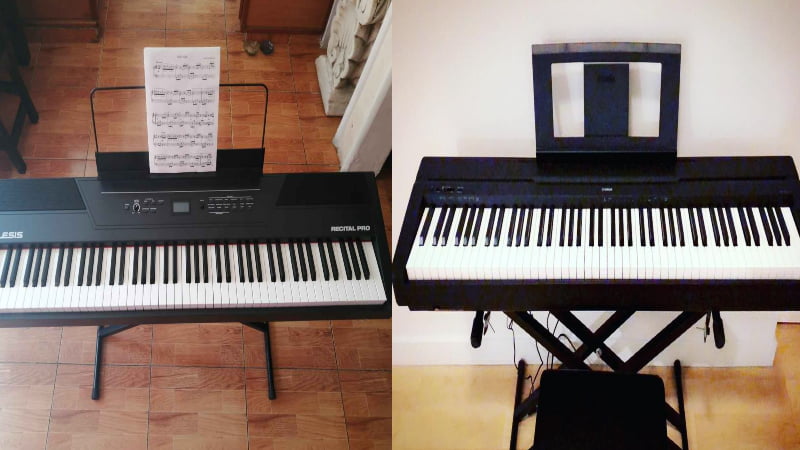While both of these models are great pianos for both beginners and novice students, the Alesis Recital Pro slightly edges out the Yamaha P71. After I tested out both models, I found that the Alesis Recital Pro came with much more features that make it a better option for students learning to play the piano. This model has more voices and extra features such as recording and split modes that are a dream for any beginner pianist.
But when writing this Yamaha P71 vs Alesis Recital Pro comparison, I did find some areas where the Yamaha P71 is the better option. For instance, it’s equipped with better tone generation technology, which gives it a slight edge in some areas. And while it can’t beat out the Alesis Recital Pro when compared head-to-head, it still makes for a great digital piano that can serve you well for many years to come.
Yamaha P71 vs Alesis Recital Pro: Comparison Chart




Last update on 2025-07-17 / Affiliate links / Images from Amazon Product Advertising API
Yamaha P71 vs Alesis Recital Pro: Differences
To find out which model was truly the best, I had to compare their features. And after putting them up head-to-head, the Alesis Recital Pro beat out the Yamaha P71 by 4-1, which made it the clear winner. The Recital Pro offers many more features that make it a versatile instrument that’s perfect for beginners, while the P71 lagged behind in most aspects, it still provided a couple of cool features that make it a good option for students as well.
Hammer Action
The winner: Tie
Both of these digital pianos come with fully-weighted keys, which gives a similar feel to an acoustic piano. On the Recital Pro, the hammer action is decent enough to resemble an acoustic piano, though it could arguably be done much better. The same can be said about the Yamaha P71, as the hammer action is good, but is lacking in some aspects.
Neither of these pianos have graded hammer action, which is kind of a let-down, considering that Yamaha digital pianos are known for their GHS (graded hammer action) systems. So, when it comes down to it, both of these pianos rank the same when it comes to the feel of the keys.
Tone
The winner: Alesis Recital Pro
When comparing the tone of these pianos, I found that they were pretty close in terms of how they sound. However, because of the additional voices and extra effects that come with the Recital Pro, it was the clear winner when comparing the two features.
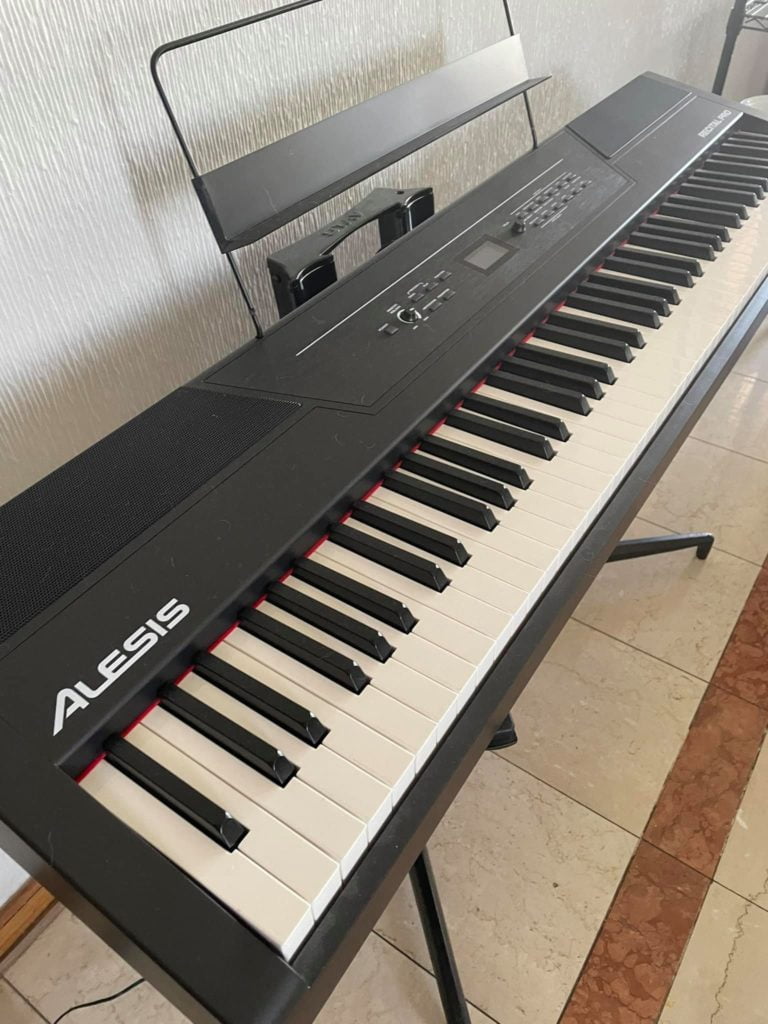
Tone Generation
This is one of the aspects where you could argue that the Yamaha P71 edges out the Alesis Recital Pro, but not by a whole lot. Both of the pianos generate their tones through samples, which means that the keys trigger a pre-recorded sound from a real instrument like an acoustic piano.
Since both brands use high-quality equipment when recording their samples, the tone comes out very crisp and clear. However, the slight edge that the Yamaha P71 has comes from the AMW Stereo Sampling technology. This system uses multiple stereo samples to create a fuller and more realistic sound. While the difference between the Alesis Recital Pro and Yamaha P71 is very small when it comes to the samples, the Yamaha P71’s tone is slightly fuller and crisper.
Sound Library
The clear winner when comparing this aspect of the tone is the Alesis Recital Pro. This is simply because the Recital Pro comes with more voices and presets than the Yamaha P71. On the P71, you only get 10 loaded voices, while the Recital Pro comes with 12.
The difference may not seem that great, but it’s a huge deal when actually playing the instrument. Both pianos have the standard voices pre-loaded such as grand piano, upright piano, organ, and strings. However, the Recital Pro has some additional voices like fingered bass and electric piano that have many applications when playing a wide variety of genres.
Because of the additional voices, the Recital Pro is the more versatile option and is a great piano for students who play a bunch of different genres.
Effects
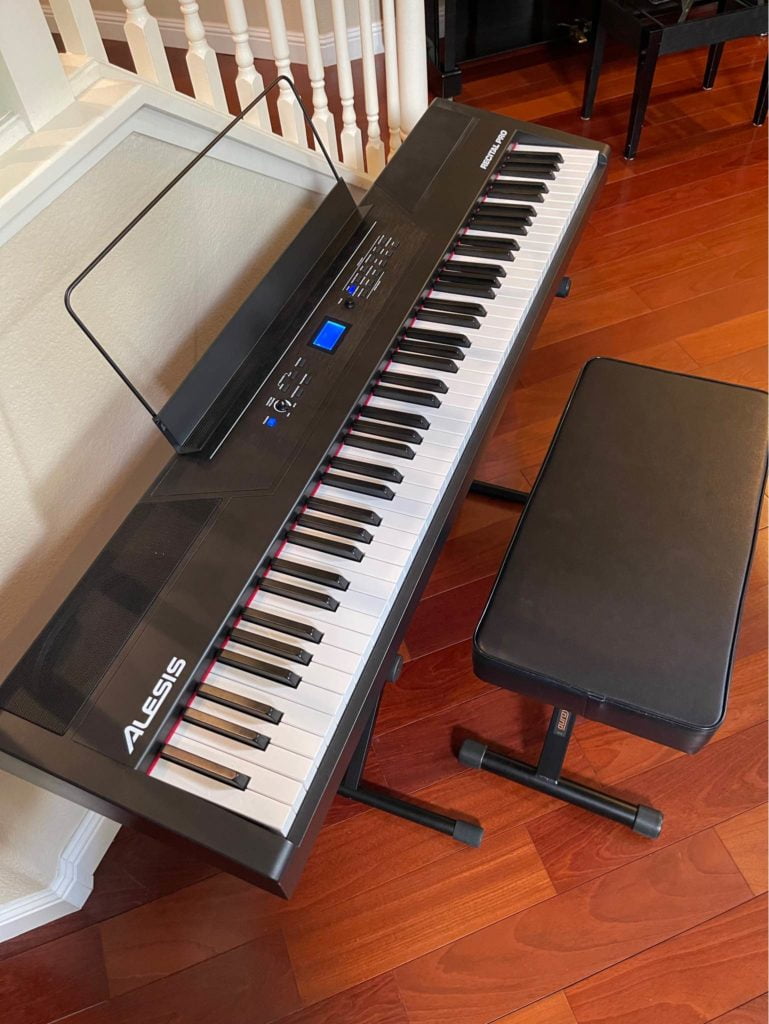
Another aspect where the Recital Pro beats out the P71 is in terms of effects. While extra effects aren’t necessary, especially for beginners, they are a great function to have. With additional effects, you can further customize the tone of your piano to really make it fit your needs and playing style.
The Yamaha P71 comes with one effect: reverb. While this may not seem like much, it can make a huge difference. The reverb on the P71 comes with 4 different presets which you can even tweak to your liking. That way, you can create a fuller sound that fits your tastes better. However, one of the downsides is that you can’t save any of the parameters you tweaked on the reverb, which gets in the way of a convenient playing experience.
The Recital Pro, on the other hand, comes with three different effects. With this piano, you get reverb, chorus, and modulation, which are all very important effects that piano players need when performing. You can use one effect at a time or combine them to create a truly unique tone. You can even tweak the settings to come up with abstract and out-of-this world sounds which is always a fun experiment for musicians.
Sound System
The winner: Alesis Recital Pro
The Yamaha P71’s sound system is lackluster, to say the least. While the two small 6W speakers are great for rehearsing on your own, that’s about all you can do with it. They are not loud enough to be heard if you’re jamming with other musicians and won’t do you any good if you’re performing on stage. Luckily, it does come with a ¼’’ output that allows you to connect the piano to an external sound system. So, if ever you find yourself at a gig with the Yamaha P71, make sure to plug in to an external sound system to ensure you’ll be heard.
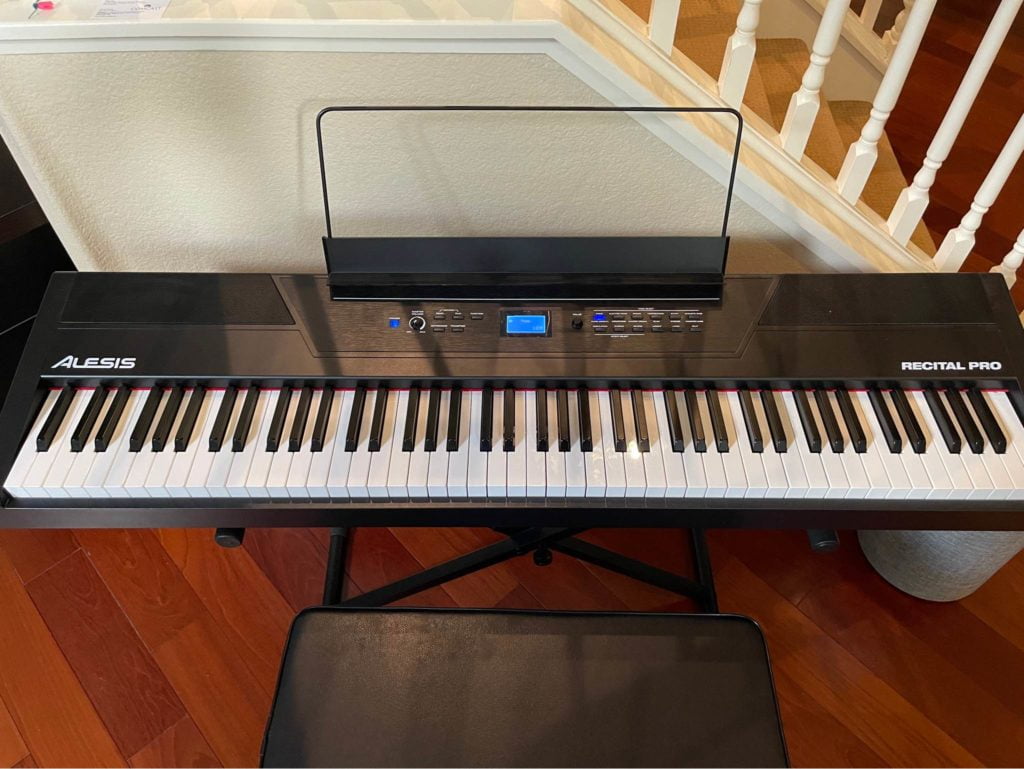
The speakers on the Alesis Recital Pro are miles ahead of the Yamaha P71. They are much louder and stronger at 20W, which is more than loud enough for solo practice and even jamming with your friends. So, because of the larger speakers, the Recital Pro has a significant advantage over the P71. On top of that, it also comes with a ¼’’ output, so you connect this piano to an external sound system as well.
Piano Features
The winner: Alesis Recital Pro
Another way the Recital Pro beats out the P71 is with it’s extra piano features. Now, keep in mind that these aren’t exactly necessary features in a digital piano, but they can make a world of a difference when comparing two models. And because of all the additional modes that come with the Recital Pro, this piano leaves the Yamaha P71 in the dust.
Polyphony
The Alesis Recital Pro has 128-note maximum polyphony. In the world of digital pianos, this is up there with the best models on the market. Since you can play more notes at a time with the Recital Pro, you can also get a much clearer and crisper tone when playing complex and spread out chords.
On the other hand, the Yamaha P71 only has 64-note maximum polyphony. This is still more than enough to play a wide variety of chords with tons of different notes. However, since it can’t process as many notes as the Recital Pro, the Yamaha P71 doesn’t give off as crisp and clear a tone when playing chords.
Lesson Mode
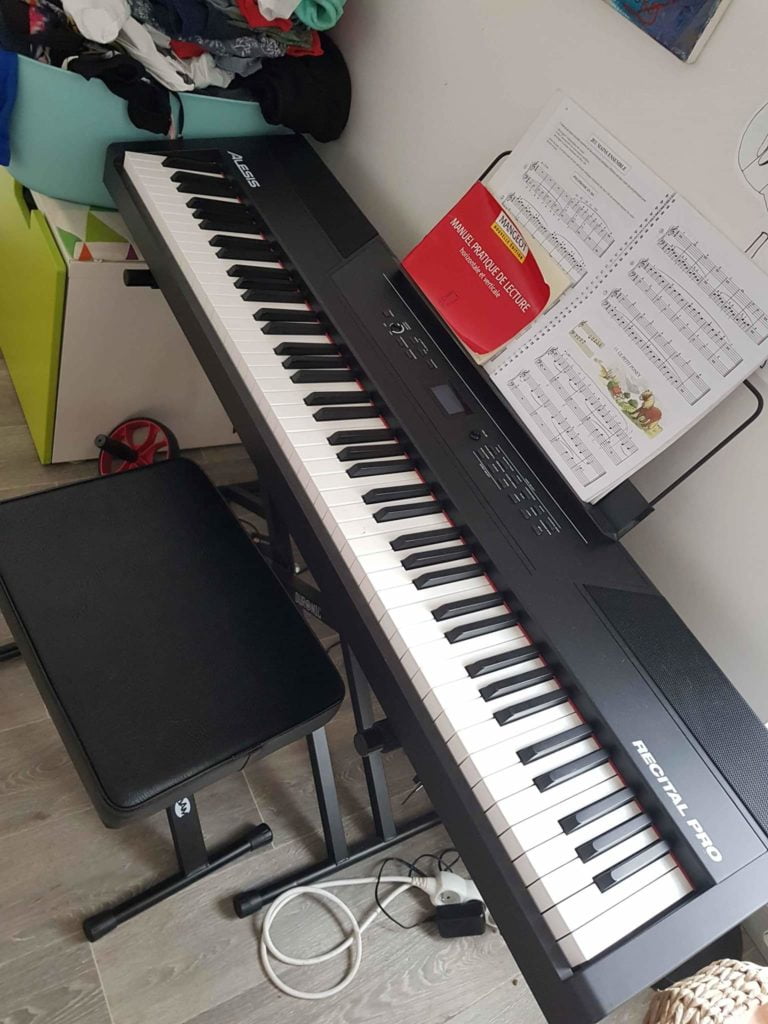
One of the main reasons the Alesis Recital Pro is such a good choice for beginners is that it comes with lesson mode. With lesson mode, the piano is divided into two sections with the same tone and voice. That way, both the teacher and the student can play the piano at the same time and get the same sound without having to reach over one another.
On top of that, when you get the Alesis Recital Pro, it comes with a 3-month subscription to Skoove. Skoove is an online piano lesson website that can serve as a virtual guide through the world of the piano. While it isn’t a substitute for a real teacher, it does a great job at augmenting your lessons and helping students hone their skills while the teacher isn’t around.
Sadly, the Yamaha P71 doesn’t come with any sort of lesson mode. However, if you already have a piano teacher, this model can still make for a great instrument to use when learning how to play.
Recording
Recording music is as important to the process as practice. When you record the way you play, you can save ideas that can turn into songs, or listen back at the recordings to hear areas wherein you can improve. With the Recital Pro, you can use the “recording” mode to record the music you play and hear it back. On top of that, you can even layer multiple recordings and create full drafts and demos of songs.
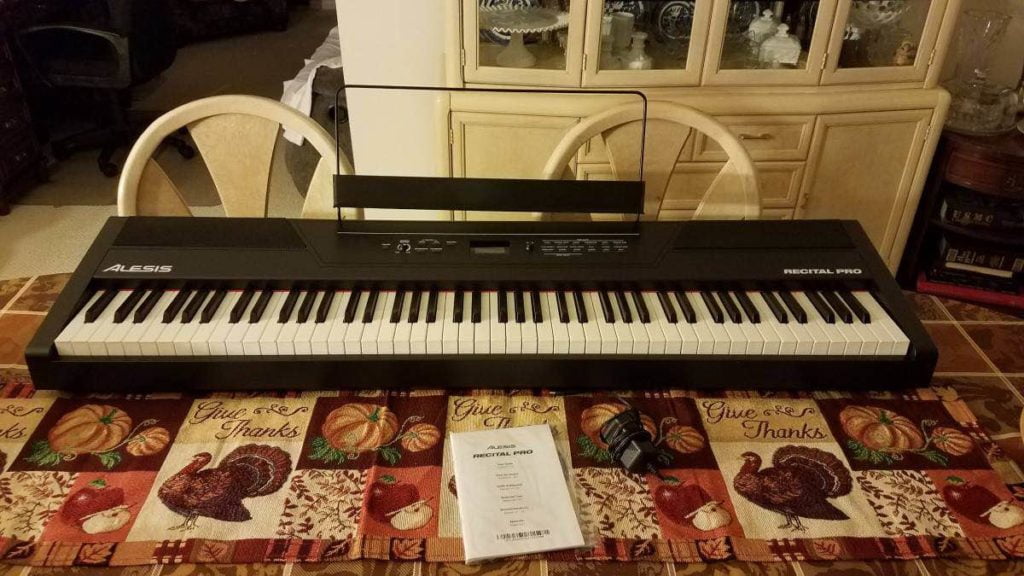
With the Yamaha P71, you don’t have an option for recording. So, if you want to record with the P71, you’ll need an external device such as an audio interface and a DAW to save the recordings. While this isn’t too much of a hassle, it is significantly harder than recording on the Alesis Recital Pro.
Split/Dual Mode
When it comes to these features, these models are tied. This is because the Alesis Recital Pro comes with split mode and no dual mode, while the Yamaha P71 comes with dual mode but no split mode. The split mode on the recital pro is great for performing and experimenting alone, as you can split the piano into two different voices. For example, the left hand side can play a fingered bass voice while the right hand can play an electric piano, which is great for performing songs with a vocalist.
On the flip side, the Yamaha P71’s dual mode offers a new twist to playing piano. Dual mode blends two different piano voices together for a truly unique sound. This is great for experimenting or even just playing around alone. On top of that, the dual mode can also make for hours upon hours of fun.
But at the end of it all, since the Recital Pro comes with way more extra features than the P71, it’s the winner when comparing the piano features of both instruments.
Yamaha P71 vs Alesis Recital Pro: The Similarities
These models don’t share a lot of similarities, but there are a couple that are worth discussing. For starters, they both have fully-weighted keys and an 88-key keyboard. This is ideal for piano students as it can give them a similar feel to playing an acoustic piano, which is crucial for learning how to play the instrument properly.
Another shared between the two is that they’re portable digital pianos. This allows musicians to easily take the instruments around with them for gigs, lessons, or even just jams with friends! But aside from what I mentioned, these two pianos don’t share any similarities. These are two very different instruments, which is why comparing the two was very interesting.
Quick Rundown of the Alesis Recital Pro
- A Digital Piano That’s Tailored to You - Feature-packed electric keyboard with 88 premium full-sized weighted hammer action keys with adjustable touch response to suit your preferred playing style
- Premium Sounds - 12 voices (Incl. Acoustic Piano, Electric Piano, Organ, Synth, and Bass), built-in FX: Chorus, Modulation, Reverb, and two built in 20W speakers for clear, room-filling sound
- All The Right Connections - ¼” sustain pedal input (pedal not included), ¼” stereo headphone output for private practice and stereo outputs for connection to speakers / amplifiers
- Play the Keyboard Wherever You Go - Power via the included power adapter or 6 D cell batteries (not included) for professional piano performance anywhere
- Powerful Educational Features - Standard, split, layer, record and lesson modes with 128-note max polyphony and Skoove 3 month premium subscription for expert interactive online piano lessons
Last update on 2025-07-17 / Affiliate links / Images from Amazon Product Advertising API
Quick Rundown of the Yamaha P71
- Acoustic Piano Feel - Touch-sensitive keys allow for true expression and dynamic performance. The weighted action replicates the acoustic piano experience
- Elevated Sound - Choose from 10 unique Voices, including the richness and resonance of a Yamaha grand piano, with full dynamic sound and deep bass
- Effortless Control - Simple one-button operation and streamlined functionality designed to keep you focused on your music
- Layered Sound - Dual Mode lets you blend two Voices, like piano and strings, creating a rich, layered sound for an inspiring new playing experience
- Included sustain pedal allows for subtle variations and greater expression in your performances
Last update on 2025-07-17 / Affiliate links / Images from Amazon Product Advertising API
Product Video:
Related Articles to Alesis Recital Pro
- Alesis Recital Pro vs Williams Legato III: Discover the Best Piano for Your Home
- Alesis Recital Pro vs Roland Go Piano 88 Comparison: Which Is The Best Portable Digital Piano?
- Alesis Recital Pro vs Yamaha NP32 Comparison: Discover the Best Piano for Your Home
- Kawai ES110 Vs Alesis Recital Pro: Should You Shell Out for the Kawai ES110?
- Alesis Recital Pro vs Prestige Comparison: Choosing the Best Entry-Level Alesis Piano
- Alesis Recital Pro vs Casio CDP-135: Which Is the Best Beginner’s Digital Piano?
- Alesis Recital Pro vs Roland FP-30: Finding the Best Digital Piano on a Budget
- Alesis Recital Pro vs Casio CDP-S150 Comparison: Which Is The Best Portable Digital Piano?
- Alesis Virtue vs Recital Pro: Which Piano Offers The Most For Beginners?
- Alesis Recital Pro vs Casio PX 160: Which Piano Comes Out On Top?
- Alesis Recital Pro vs Roland FP 10: Why You Should Go For The Alesis Recital Pro
- Alesis Recital Pro vs Korg B2 Comparison: Which Digital Piano Should You Get?
- Alesis Recital Pro vs Williams Allegro 3 Comparison: Which One Is Worth Your Money?
- Alesis Recital Pro vs Yamaha P125 Comparison: Which Is The Best Portable Digital Piano?
- Alesis Recital vs Alesis Recital Pro: Should You Invest In The Recital Pro?
- Alesis Recital Pro vs Yamaha P45: Which Should You Get As Your First Piano?
- Donner DEP-20 vs Alesis Recital Pro Comparison: Two Great Pianos Designed for Beginners
- Alesis Prestige Artist vs Recital Pro: Which Is the Best Alesis Piano for Beginners?
Related Articles to Yamaha P71
- Alesis Virtue Vs Yamaha P71: Can The Alesis Console Piano Beat Out The Amazon Exclusive?
- Yamaha P71 vs P95: Which Is The Better Digital Piano?
- Yamaha P71 vs Korg B2 Comparison: Battle Of the Two Top Beginner Pianos On the Market
- Yamaha P71 vs Casio CDP-S150: Which Is the Best Beginner Piano On the Market?
- Yamaha P71 vs DGX-660: Can the Amazon Exclusive Beat Out the Premium Model?
- Yamaha P71 vs Donner DEP-20: Which Is the Best Beginner Piano?
- Yamaha P71 vs Casio PX-160 Comparison: Battle of the Two Best Digital Pianos on a Budget
- Yamaha P71 vs Alesis Recital: Why the Amazon Exclusive P71 Is the Best Option for Beginners
- Yamaha P71 vs Roland FP10 Review: A Tight-Knit Battle Where The FP10 Comes Out On Top
- Yamaha P71 vs P125: Why the Yamaha P125 Is the Better Investment
- Yamaha P71 vs P45: Why the Amazon Exclusive P71 is the Better Digital Piano
References:
- RECITAL PRO 88-Key Digital Piano with Hammer-Action Keys: https://www.alesis.com/products/view/recital-pro
Lulacruza is an electronic folk duo operating at the junction of the hypermodern and the ancient. Our music weaves together hypnotic female singing, South American folk instruments and electronic processing, while channeling pulsating waves from the source of creation.
Lalucruza is also a community where you can connect with other music lovers to collaborate, exchange ideas and share knowledge. A platform for who wants to learns the basics of playing piano, guitar, drum masters’ technique, etc.. is the premise of our website.
